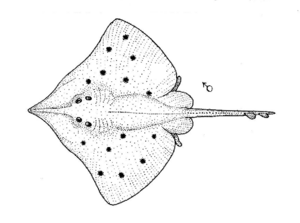New Zealand smooth skate facts for kids
Quick facts for kids New Zealand smooth skate |
|
|---|---|
 |
|
| Drawing by Dr Tony Ayling | |
| Conservation status | |
| Scientific classification |
The New Zealand smooth skate (Dipturus innominatus) is a type of skate fish. You can find them around New Zealand in waters that are 15 to 1,300 meters deep. These amazing creatures are known for their large size and unique way of life on the seafloor.
Contents
What Does the New Zealand Smooth Skate Look Like?
Male smooth skates can grow up to 93 centimeters long. This measurement, called pelvic length (PL), goes from the tip of their snout to the outer edge of their pelvic fins. Female smooth skates are even bigger! They can reach about 112 centimeters PL. The longest female ever recorded was an incredible 158 centimeters PL.
These skates are the largest known skates in the world. They can weigh up to 70 kilograms when they are fully grown. Some have even been reported to be 2.4 meters long! Their top side is dark grey with darker spots, while their underside is a lighter grey or white. Some adult skates have small prickles or "whiskers" on their snouts. People sometimes confuse smooth skates with rough skates. However, smooth skates are generally larger and have a lighter color.
Where Do New Zealand Smooth Skates Live?
The New Zealand smooth skate is endemic to New Zealand. This means they are only found there and nowhere else in the world. You can spot them in the coastal waters around New Zealand's North, South, and Stewart Islands. They also live near the Snares Islands shelf and the Chatham Rise.
Smooth skates live from the shoreline down to about 1200 meters below sea level. But it's rare to find them deeper than 800 meters. They prefer soft areas on the seafloor, especially on the continental shelf and its upper slope. They are most common in the middle to outer parts of the continental shelf.
What Do New Zealand Smooth Skates Eat?
D. innominatus skates live near the seabed, which is the bottom of the ocean. They are bottom-feeding predators, meaning they hunt for food on the seafloor. They also act as scavengers, eating dead fish and leftover scraps from bigger predators. Their diet doesn't change based on how deep the water is or whether they are male or female.
However, their diet does change as they grow older. When they are young, most of their food is small crustaceans. As they get older, they start eating larger crustaceans and small fish. When they become fully grown, they mostly eat larger fish and any leftover fish from other predators or from commercial fishing boats. At this stage, they no longer eat the small crustaceans they enjoyed when they were younger. This change in diet is also seen in another skate species, Sympterygia acuta.
Adult smooth skates mainly eat shrimp, prawns, and fish from many different families. Some of their favorite foods include hoki, which is a type of deepwater cod. They also eat many different kinds of fish that are thrown away by the commercial fishing industry.
Who Hunts the New Zealand Smooth Skate?
We don't know much about what preys on D. innominatus, or what parasites and diseases affect them. We do know that marine mammals, especially seals, eat other types of skates. So, it's likely that New Zealand seals also eat smooth skates. It can be hard to tell if skates are part of a seal's diet because skates don't have many bony parts that are easy to find when scientists check seal stomachs.
Sometimes, snails (gastropods) are known to eat the egg cases of some skate species.
Humans also impact New Zealand smooth skate populations through fishing. Smooth skates are often caught by accident, which is called "bycatch," by fishing boats that are trying to catch hoki.
How Are New Zealand Smooth Skates Protected?
In June 2018, the New Zealand Department of Conservation looked at the New Zealand smooth skate. They decided to classify it as "Not Threatened." This means it's not currently in danger of disappearing. However, they also added the qualifier "Conservation Dependent." This means that even though it's not threatened now, it still needs ongoing efforts to protect it and make sure its population stays healthy.
See also
 In Spanish: Dipturus innominatus para niños
In Spanish: Dipturus innominatus para niños


